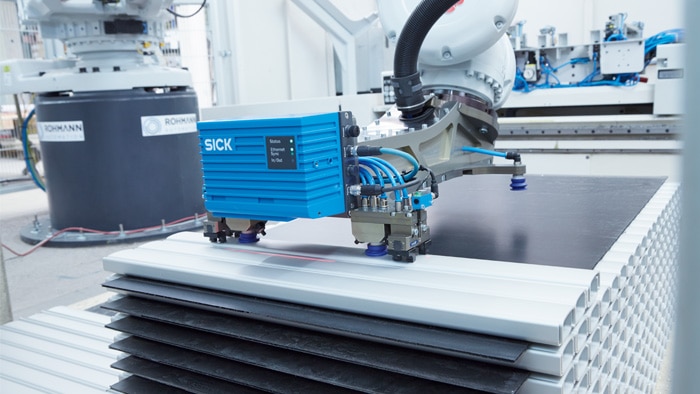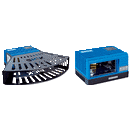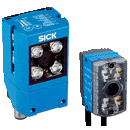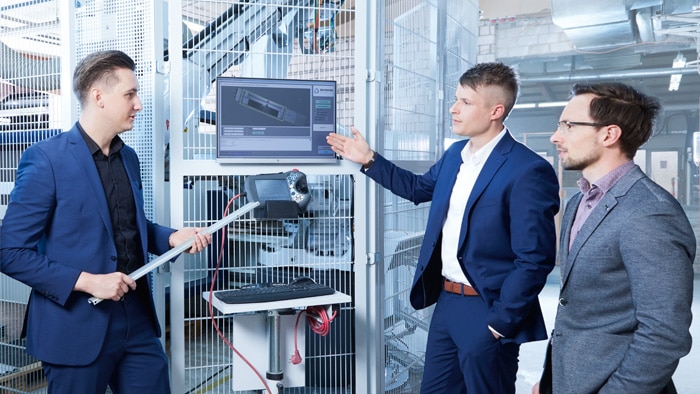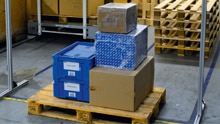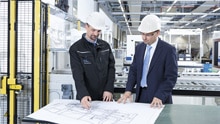The robot arms reach for the aluminum profiles with lighting speed. The unmachined parts are fed to the milling machine, and the finished parts are restacked on the pallet. This functions like clockwork and as if by magic – however the agents in this scenario are neither super-natural nor fanciful. In collaboration with the company Rohmann-Automation GmbH, it is SICK products that are here at work performing palletizing and depalletizing for the automotive supplier MS-Schuon GmbH in order to process important components for fitting out camping vehicles. The LMS4000 2D LiDAR sensor acts as a high-resolution “eye” for the robot arms. And the GTB6 photoelectric proximity sensor also plays an important role in carrying out this process.
An application that hits the mark: palletizing and depalletizing using a 2D LiDAR sensor
It is not always possible to appreciate the relationship between one’s own work or products and what we are experiencing. And not everyone sitting and relaxing in their own RV while on a camping holiday would necessarily be thinking about how the 2D LiDAR sensor from SICK and the systems integration involvement of Rohmann-Automation has contributed to that RV. But anyone who has had the opportunity to observe the rhythm and elegance of the robot choreography in the production facilities at MS-Schuon GmbH could not help being spellbound by it. And also appreciate the part that highly reliable automated processes play in all of this.
With the LMS4000, the robots “see” every angle
Two industrial robots supply aluminum profiles of various lengths to an automatic drilling and milling machine. The two robot arms palletize and depalletize at the same time. The aluminum profiles that are later incorporated into tables and loungers are fed to the clamping fixtures of a fully automated drilling and milling machine and subsequently removed again. This is made possible by two LMS4000 2D LiDAR sensors, one of which is mounted on each of the two robot arms. This sensor is particularly suitable for applications where goods need to be analyzed and moved quickly and in a targeted manner. The LMS4000 reliably detects the position and shape of parts, in this case aluminum profiles. The high sampling density and the broad dynamic range of this sensor are also crucial features here. The major advantage for this application: no magazining is required. Whereas comparable applications have in the past generally used expensive magazines with defined pickup positions, the method described here is significantly more flexible and cost-effective.
Thanks to its measurement capabilities, the sensor can detect the parts even if they are lying criss-cross or rotated on the pallet. The length and position of the entire pallet is also detected reliably thanks to the 3D evaluation and taken into consideration by the gripper. Pallets that are displaced by several centimeters or rotated by several degrees no longer present a problem – even tilted pallets and uneven industrial floors do not impair the robots in any way. The worker can position the pallet by eye in the robot cell – the LMS4000 controls the rest.
A sensor that can also “read between the lines”
The aluminum profiles are stacked on the pallets both in their unfinished and finished state with the help of black, surface-protecting rubber liners. After each layer of profiles has been removed, the liner is moved from the raw materials pallet to an extra pallet. When loading the finished parts pallet with finished parts, the gripper fetches the liners again from the extra pallet. For many sensors in the same price segment, the material properties of the liners, namely the dark black rubber combined with a thickness of barely 1 to 2 mm, present an insurmountable hurdle. Not so for the LMS4000: The 2D LiDAR sensor transmits not only distance values but also remission data. This can be used to create a 3D model that takes into consideration not only the pure height information but also the surface properties of objects. The sensor can therefore directly distinguish even the slightest color or material differences, which enables the liner to be reliably identified. This is unique in the market and cannot be achieved in this manner using even the most complex 3D cameras.
A GTB6 helps to maintain the correct timing in the process. Two GTB6s per robot arm verify that the aluminum parts and also the liners have been picked up correctly. The GTB6s ensure suction is applied by the vacuum grippers at the correct moment and that no parts fall down.
System integration by a strong partner
Thanks to the outstanding capabilities of the LMS4000, the sensor is able to detect both the position of a pallet as well as the profiles and liners stored on them. Specialist expertise is, of course, also required for commissioning and system integration. The company Rohmann-Automation GmbH offers exactly that with its turnkey and tailored complete robotics solutions: “We have been successfully working in the area of robotics for many years and have implemented for various customers a wide spectrum of applications from pick-and-place right through to end-of-arm tooling”, confirms the general manager Jascha Rohmann. “In doing so, we have found in SICK a partner whose products not only more than satisfy the requirements of our customers, but also meet our expectations on perfection and partnership.” Rohmann acts as the interface to the end-customer firstly as a software producer and competent system integrator who can offer remote maintenance as well as on-site commissioning, and secondly as an ambassador for SICK’s competence as a sensor expert. A partnership that quite clearly works and hits the mark.
Read more
Top ways to use vision sensors for palletizing
All good? But of course! Complete solutions for pallet handling
Faster in depalletizing: Robots see more with 3D snapshot technology
